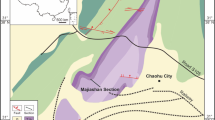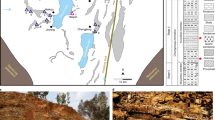Abstract
Of the 21 or so generally accepted animal phyla, only one, the Ctenophora, has no fossil record1. The Phylum Ctenophora or comb jellies, are typically globular, swimming marine organisms, widely distributed in today's oceans. They are small, delicate, mostly planktonic animals of a gelatinous nature2 that were first considered to be coelenterates but later were recognized as a distinct group of phylum rank. We have now discovered the pyritized fossil remains of a small, globular, soft-bodied ctenophore. It comes from the Lower Devonian Hunsrück Slate of West Germany and provides the first tangible evidence for the existence of the group. Our discovery demonstrates that the basic ctenophore body plan has changed very little over the past 400 Myr and suggests that the origin of the phylum must extend even further back in time.
This is a preview of subscription content, access via your institution
Access options
Subscribe to this journal
Receive 51 print issues and online access
$199.00 per year
only $3.90 per issue
Buy this article
- Purchase on Springer Link
- Instant access to full article PDF
Prices may be subject to local taxes which are calculated during checkout
Similar content being viewed by others
References
Geczy, B. Acta biol. Acad. Sci. Hung. 31, 461–464 (1980).
Bayer, F. M. & Owre, H. B. The Free-Living Lower Invertebrates (Macmillan, London, 1968).
Mittmeyer, H.-G. Natur Mus., Frankf. 110, 34–39 (1980).
Stürmer, W. Natur Mus., Frankf. 110, 3–18 (1980).
Stürmer, W. & Bergstrom, J. Paläont. Z. 47, 104–141 (1973).
Stürmer, W. Science 170, 1300–1302 (1970).
Rauff, H. Paläont. Z. 21, 194–213 (1939).
Yochelson, E. L., Stürmer, W. & Stanley, G. D. Jr Paläont. Z. (in the press).
Wells, J. W. & Hill, D. in Treatise on Invertebrate Paleontology Pt F (ed. Moore, R. C.) F478 (Geological Society of America and University of Kansas Press. 1956).
Gürich, G. Int. geol. Congr. S. Af. 1929 15, 670–680 (1930).
Moore, R. C. in Treatise on Invertebrate Paleontology Pt O (ed. Moore, R. C.) 016–021 (Geological Society of America and University of Kansas Press, 1959).
Glaessner, M. F. Nature 183, 1472–1473 (1959).
Glaessner, M. F. Scient. Am. 204, 72–78 (March) (1961).
Hyman, L. H. Invertebrates: Protozoa through Ctenophora (McGraw-Hill, New York, 1940).
Harbison, G. R., Madin, L. P. & Swanbert, N. R. Deep-Sea Res. 25, 233–255 (1978).
Barrington, E. J. W. Invertebrate Structure and Function (Nelson, Sunbury-on-Thames, 1979).
Scrutton, C. T. in The Origin of Major Invertebrate Groups (ed. House, M. R.) 161–207 (Academic, New York, 1979).
Author information
Authors and Affiliations
Rights and permissions
About this article
Cite this article
Stanley, G., Stürmer, W. The first fossil ctenophore from the Lower Devonian of West Germany. Nature 303, 518–520 (1983). https://doi.org/10.1038/303518a0
Received:
Accepted:
Published:
Issue Date:
DOI: https://doi.org/10.1038/303518a0
This article is cited by
-
A late-surviving stem-ctenophore from the Late Devonian of Miguasha (Canada)
Scientific Reports (2021)
-
Supposed soft tissue preservation in the Hunsrückschiefer (Lower Devonian, Rheinisches Schiefergebirge): the example of brachiopods
Paläontologische Zeitschrift (2000)
-
A small coleoid cephalopod with soft parts from the lower Devonian discovered using radiography
Nature (1985)
Comments
By submitting a comment you agree to abide by our Terms and Community Guidelines. If you find something abusive or that does not comply with our terms or guidelines please flag it as inappropriate.



